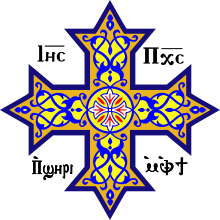John the Dwarf
| Saint John the Dwarf | |
|---|---|
_-_John_Kolobos.jpg) Mosaic in Hosios Loukas | |
| Born |
c. 339 Thebes, Egypt[1] |
| Died |
c. 405 Mount Colzim, Egypt |
| Venerated in | Roman Catholic Church, Eastern Orthodox Churches, Oriental Orthodox Churches |
| Feast | October 17 = Paopi 20, November 9 (Eastern Orthodox Church) |
| Attributes | Short Monk watering a stick |
Saint John the Dwarf (Greek: Ιωάννης Κολοβός; Arabic: ابو يحنّس القصير (Abū) Yuḥannis al-Qaṣīr c. 339 – c. 405), also called Saint John Colobus, Saint John Kolobos or Abba John the Dwarf,[2] was an Egyptian Desert Father of the early Christian church.
Life
John the Dwarf was born in the town of Thebes in Egypt[3] to poor Christian parents. At the age of eighteen, he and an elder brother, moved to the desert of Scetes[4] where he became a disciple of Saint Pambo and a good friend of Saint Pishoy. He lived a life of austerity and taught several other monks his way of life, among them was Arsenius the Great.
After the departure of Saint Pambo, John was ordained a priest by Pope Theophilus and became abbot of the monastery he founded around the Tree of Obedience. When the Berbers invaded Scetes in 395, John fled the Nitrian Desert and went to live on Mount Colzim, near the present city of Suez, where he died.
In 515, the relics of Saint John the Dwarf were moved to the Nitrian Desert. His feast is celebrated on October 17 in the Roman Catholic Church, on 20 Paopi at the Coptic Orthodox Church and on November 9 in the Eastern Orthodox Church. The Monastery of Saint John the Dwarf in Scetes is now deserted.
Legend
John the Dwarf is best known for his obedience. The most famous story about his obedience is that one day Saint Pambo gave Abba John a piece of dry wood and ordered him to plant and water it. John obeyed and went on watering it twice a day even though the water was about 12 miles from where they lived. After three years, the piece of wood sprouted and grew into a fruitful tree. Pambo took some of this tree's fruits and went around to all the elder monks, saying "take, eat from the fruit of obedience". Postumian, who was in Egypt in 402, assured that he was shown this tree which grew in the yard of the monastery and which he saw covered with shoots and green leaves.
John Cassian tells a similar story of John of Egypt, only he was asked to tend the stick only one year, it did not bloom, and after this test of obedience his superior threw the stick away. According to William Harmless, "Scholars presume that Cassian was closer to the event and may be the more dependable reporter..."[5]
References
- ↑ https://st-takla.org/Saints/Coptic-Orthodox-Saints-Biography/Coptic-Saints-Story_1969.html
- ↑ Ward, Benedicta (1975). The Sayings of the Desert Fathers: The Alphabetical Collection. Cistercian Publications. ISBN 978-0879079598.
- ↑ "القديس يوأنس القصير | الأنبا يحنس القصير | أنبا يوحنا القصير | St-Takla.org". st-takla.org. Retrieved 2018-03-17.
- ↑ Butler, Alban. "St. John the Dwarf, Anchoret of Sceté", The Lives of the Saints, Vol.IX, 1866
- ↑ Harmless, William. Desert Christians: An Introduction to the Literature of Early Monasticism, Oxford University Press, USA, 2004, ISBN 9780195162226, p. 222
